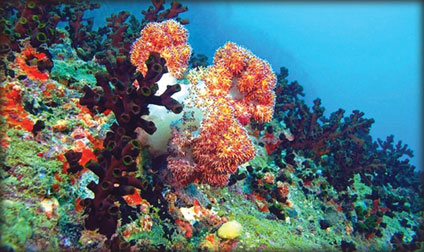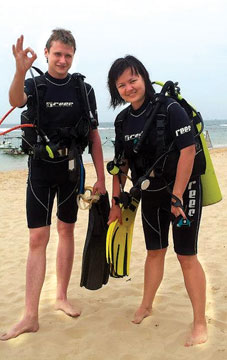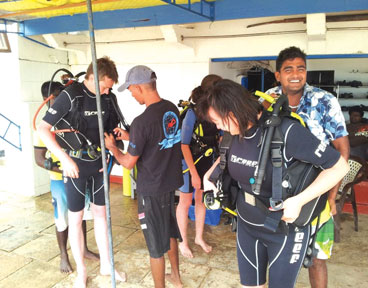Hikkaduwa, a paradise for divers again
by W.T.J.S. Kaviratne, Ambalangoda special Cor
Hikkaduwa, on the South Coast, has again become a much sought after
destination of international divers. There are several diving centres of
international standard at Hikkaduwa, catering to all requirements of
divers. The diving centres are fully equipped with diving gear and
comprise experienced and qualified divers having PADI licence conducting
theoretical and practical lessons on diving for foreign and local diving
enthusiasts.
 Some of the diving centres in Hikkaduwa even obtain foreign expertise
in their training programs. International diving trainers having PADI
(Professional Association of Diving Instructors) licence reach some of
these diving centres at Hikkaduwa to provide their services in
collaboration with their local counterparts. Some of the diving centres in Hikkaduwa even obtain foreign expertise
in their training programs. International diving trainers having PADI
(Professional Association of Diving Instructors) licence reach some of
these diving centres at Hikkaduwa to provide their services in
collaboration with their local counterparts.
Licence holding divers of PADI, which is the largest diver training
organisation in the world, provide diving training at these diving
training centres in Hikkaduwa.
The PADI Open Water Diver Course is divided into three segments –
Academic Training, Confined Water Training and Open Water Training.
Hikkaduwa automatically became the first beach destination in Sri
Lanka and remained so for more than a century, mainly due to the
existence of underwater ‘Coral Gardens’ now known as the Marine
Sanctuary. The Coral Gardens at Hikkaduwa could entice hundreds of
foreign holiday-makers to Sri Lanka.
Even internationally renowned marine biologists, naturalists,
conservationists and scientists frequented the Hikkaduwa Coral Gardens
Marine Sanctuary from time immemorial.
Dr. Ransonnet, a Viennese, was one of the earliest divers to come in
search of the Coral Gardens at Hikkaduwa, to enjoy the enchanting beauty
and marvels of this underwater fairyland.
In the past, long before the advent of tourism as an industry in Sri
Lanka, there was a tiny rest house at Hikkaduwa, in the middle of a
sprawling coconut land bordering the sea. There were only a few rooms in
this old rest house which were mostly occupied by British nationals
during the heyday of horse racing at the Boossa Race Course.
Multi-coloured corals
The main occupations of the people who lived close to the Hikkaduwa
sea stretch during those days were fishing and coral mining. Some
fishermen had cited a garden of multi-coloured corals in the rocky sea
just behind Hikkaduwa Rest House.
 In the past, before the introduction of hundreds of glass bottomed
boats, there was less tourist traffic. That, as well as the simple
lifestyles of the coastal community, had hardly any harmful impact on
this sensitive ecosystem and the corals were preserved. In the past, before the introduction of hundreds of glass bottomed
boats, there was less tourist traffic. That, as well as the simple
lifestyles of the coastal community, had hardly any harmful impact on
this sensitive ecosystem and the corals were preserved.
A primitive device, a glass fixed to the bottom of a wooden box, was
used then to have a view of the underwater corals from a dugout canoe.
Realising the potential of the coral formations as a tourist
attraction, the then Minister of Tourism R.G. Senanayake had donated the
first glass bottomed boat to the Hikkaduwa Rest House. Thus, the
Hikkaduwa Rest House, which was later taken over by a private company,
changed over from the old rest house and changed its name to ‘Coral
Garden Hotel’, in tune with its location, marking the presence of the
underwater garden of coral.
Adapting to the underwater world, divers experience a new sensation
such as being almost weightless. According to the divers, it is an
entirely new world where seeing and hearing things, staying warm and
moving are totally different from the same activities carried out on
land. This is because water is 800 times denser than air and underwater
sounds travel about four times faster than in the atmosphere. When you
are under water, sound comes in all directions at once.
The human eye cannot focus without an air space and the mask worn by
the diver provides such a space.
“Once the basic equipment is worn, and training is given about its
use, the diver, like a space traveller, would enter another world; a
world full of fantasy and mystery, of new colours, of diverse forms of
life, new shapes and a world where one can even fly. When a diver is
under water, he/she gets a strange feeling that he/she is part of the
marine ecosystem which has been hardly experienced on land,” some of the
divers of Hikkaduwa revealed.
Aquatic, terrestrial animals
Comparing the aquatic animals to terrestrial animals, they said that
the fish the divers might come across while diving become friendly with
the divers and sometimes follow them, unlike land animals who usually
keep away from human beings.
 |
|
ady to dive |
Divers across the world are great advocates of conservation and
marine ecosystems are considered as unspoilt parts of the natural world.
Divers said that it was a great tragedy to observe that even the ocean
depths at Hikkaduwa were being polluted and destroyed as a result of
unsustainable methods of fishing and numerous other human activities.
“Look but don’t touch” is the general rule that had to be followed by
snorkelers and divers, but it appeared that even some local divers
violated this rule.
In addition, the increase of sea surface temperature which started
occurring around 1998 due to the phenomenon known as ‘El Nino’, bleached
the shallow water coral formations in the sea stretch of Hikkaduwa at an
alarming rate. Internationally recognised diver, ardent conservationist
and owner of the International Diving Centre of Hikkaduwa, Somadasa de
Silva successfully launched a program of re-planting corals, but it had
to be abandoned due to lack of funds.
Two Germans, Milan and Maya have joined the team of local diving
trainers at the Hikkaduwa International Diving Centre in conducting
practical and theoretical diving lessons for foreign and local diving
enthusiasts.These international divers, who had just returned from their
diving tours, revealed that Hikkaduwa had vast potential to expand as
one of the hotspots of the world for diving due to the existence of the
Marine Sanctuary and the large number of shipwrecks found on the ocean
bed in and around Hikkaduwa.
|



